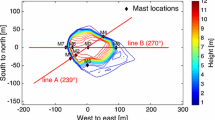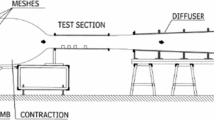Abstract
The large-eddy simulation (LES) is an efficient method for the study of atmospheric boundary layer (ABL) flow over complex terrain. However, the robustness of LES is influenced by dynamics methods for the subgrid-scale stress, which remains one of the challenging issues. Here, we present a scale-adaptive LES methodology to study ABL flow over complex terrain. We present a canopy stress method for LES over complex terrain, which provides no-slip and shear-stress boundary conditions using a cost-effective Cartesian mesh. We consider measurements from wind tunnel experiments for the investigation of a scale-adaptive subgrid-scale modeling framework for LES of wind flow over a hilly terrain. A flow simulation is then performed on six cases of ABL flow over an idealized complex terrain. The LES result is also compared against the measurement of wind over Askervein hill. The dynamic and non-dynamic versions of the turbulence kinetic energy-based subgrid model are also considered to illustrate the scale-adaptive nature of subgrid-scale turbulence. It was observed that ignoring scale-adaptivity of subgrid turbulence, LES can under-predict shear-stress, turbulence kinetic energy, and other statistical measures of atmospheric turbulence.








Similar content being viewed by others
References
Alam JM, Fitzpatrick LPJ (2018) Large eddy simulation of urban boundary layer flows using a canopy stress method. Comput Fluids 171:65–78
Anderson W (2013) An immersed boundary method wall model for high-Reynolds-number channel flow over complex topography. Int J Numer Methods Fluids 71:1588–1608
Arthur RS, Mirocha JD, Lundquist KA, Street RL (2019) Using a canopy model framework to improve large-eddy simulations of the neutral atmospheric boundary layer in the weather research and forecasting model. Mon Weather Rev 147(1):31–52
Bao J, Chow FK, Lundquist KA (2018) Large-eddy simulation over complex terrain using an improved immersed boundary method in the weather research and forecasting model. Mon Weather Rev 146(9):2781–2797
Berg J, Mann J, Bechmann A, Courtney MS, Jørgensen HE (2011) The bolund experiment, part I: Flow over a steep, three-dimensional hill. Boundary-Layer Meteorol 141(2):219
Bose ST, Park GI (2018) Wall-modeled large-eddy simulation for complex turbulent flows. Annu Rev Fluid Mech 50(1):535–561
Bradley EF (1980) An experimental study of the profiles of wind speed, shearing stress and turbulence at the crest of a large hill. Q J R Meteorol Soc 106(447):101–123
Brown AR, Hobson J, Wood N (2001) Large-eddy simulation of neutral turbulent flow over rough sinusoidal ridges. Bound-Layer Meteorol 98(3):411–441
Chow FK, Schär C, Ban N, Lundquist KA, Schlemmer L, Shi X (2019) Crossing multiple gray zones in the transition from mesoscale to microscale simulation over complex terrain. Atmosphere 10(5)
Chung D, Pullin DI (2009) Large-eddy simulation and wall modelling of turbulent channel flow. J Fluid Mech 631:281–309
De Lemos MJ (2012) Turbulence in Porous Media: Modeling and Applications. Elsevier, London
Farge M, Kevlahan NR, Perrier V, Schneider K (1999) Turbulence analysis, modelling and computing using wavelets. In: Wavelets and physics, pp 117. Cambridge University Press, Cambridge
Finnigan JJ, Shaw RH, Patton EG (2009) Turbulence structure above a vegetation canopy. J Fluid Mech 637:387–424
Germano M, Piomelli U, Moin P, Cabot WH (1991) A dynamic subgrid scale eddy viscosity model. Phys Fluids A 3(7):1760–1775
Goodfriend L, Chow FK, Vanella M, Balaras E (2015) Improving large-eddy simulation of neutral boundary layer flow across grid interfaces. Mon Weather Rev 143:3310–3326
Gopalan H, Heinz S, Stöllinger M (2013) A unified rans-les model: computational development, accuracy and cost. J Comput Phys 249:249–274
Ishihara T, Fujino Y, Hibi K (2001) A wind tunnel study of separated flow over a two-dimensional ridge and a circular hill. J Wind Eng Ind Aerodyn 89:573–576
Jenkins GJ, Mason PJ, Moores WH, Sykes RI (1981) Measurements of the flow structure around ailsa craig, a steep, three-dimensional, isolated hill. Q J R Meteorol Soc 107(454):833–851
Kaimal JC, Wyngaard JC, Izumi Y, Coté OR (1972) Spectral characteristics of surface-layer turbulence. Q J R Meteorol Soc 98(417):563–589
Kurowski MJ, Teixeira J (2018) A scale-adaptive turbulent kinetic energy closure for the dry convective boundary layer. J Atmos Sci 75(2):675–690
Lilly DK (1967) The representation of small-scale turbulence in numerical simulation experiments. NCAR Manuscr 281:99–164
Liu Z, Ishihara T, Tanaka T, He X (2016) Les study of turbulent flow fields over a smooth 3-d hill and a smooth 2-d ridge. J Wind Eng Ind Aerodyn 153:1–12
Lundquist KA, Chow FK, Lundquist JK (2010) An immersed boundary method for the weather research and forecasting model. Mon Weather Rev 138(3):796–817
Lundquist KA, Chow FK, Lundquist JK (2012) An immersed boundary method enabling large-eddy simulations of flow over complex terrain in the wrf model. Mon Weather Rev 140(12):3936–3955
Mahrer Y (1984) An improved numerical approximation of the horizontal gradients in a terrain-following coordinate system. Mon Weather Rev 112(5):918–922
Mason PJ, King JC (1985) Measurements and predictions of flow and turbulence over an isolated hill of moderate slope. Q J R Meteorol Soc 111(468):617–640
Mason PJ, Thomson D (1992) Stochastic backscatter in large-eddy simulations of boundary layers. J Fluid Mech 242:51–78
Moeng CH (1984) A large-eddy-simulation model for the study of planetary boundary-layer turbulence. J Atmos Sci 41(13):2052–2062
Moeng CH, Sullivan P (2015) Encyclopedia of atmospheric sciences, 2nd edn, vol 4, pp 232–240. Elsevier Ltd, Academic Press
Nicoud F, Ducros F (1999) Subgrid-scale stress modelling based on the square of the velocity gradient tensor. Flow Turbul Combust 62(3):183–200
Nicoud F, Toda HB, Cabrit O, Bose S, Lee J (2011) Using singular values to build a subgrid-scale model for large eddy simulations. Phys Fluids 23(8):085106
Piomelli U, Balaras E (2002) Wall-layer models for large-eddy simulations. Annu Rev Fluid Mech 34(1):349–374
Pope SB (2000) Turbulent Flows. Cambridge University Press, Cambridge
Senocak I, Ackerman A, Kirkpatrick M, Stevens D, Mansour N (2007) Study of near-surface models for large-eddy simulations of a neutrally stratified atmospheric boundary layer. Bound-Layer Meteorol 124:405–424
Shaw RH, Schumann U (1992) Large-eddy simulation of turbulent flow above and within a forest. Bound Layer Meteorol 61:47–64
Smagorinsky J (1963) General circulation experiments with the primitive equations: I. The basic experiment*. Mon Weather Review 91(3):99–164
Taylor GI (1938) The spectrum of turbulence. Proc R Soc Lond Ser A Math Phys Sci 164(919):476–490
Taylor PA, Teunissen HW (1987) The askervein hill project: overview and background data. Bound-Layer Meteorol 39(1):15–39
Trias FX, Folch D, Gorobets A, Oliva A (2015) Building proper invariants for eddy-viscosity subgrid-scale models. Phys Fluids 27(6):065103
Wang H, Takle ES (1995) Boundary-layer flow and turbulence near porous obstacles. Bound-Layer Meteorol 74(1–2):73–88
Whitaker S (1999) The method of vol averaging. Springer, New York
Acknowledgements
The authors acknowledge the computational facilities provided by the Compute Canada (graham.computecanada.ca). JMA acknowledges financial support from NSERC, and MASB acknowledges President awards and SWASP funds of the Memorial University of Newfoundland.
Author information
Authors and Affiliations
Corresponding author
Additional information
Publisher's Note
Springer Nature remains neutral with regard to jurisdictional claims in published maps and institutional affiliations.
Rights and permissions
About this article
Cite this article
Bhuiyan, M.A.S., Alam, J.M. Scale-adaptive turbulence modeling for LES over complex terrain. Engineering with Computers 38, 1995–2007 (2022). https://doi.org/10.1007/s00366-020-01190-w
Received:
Accepted:
Published:
Issue Date:
DOI: https://doi.org/10.1007/s00366-020-01190-w




